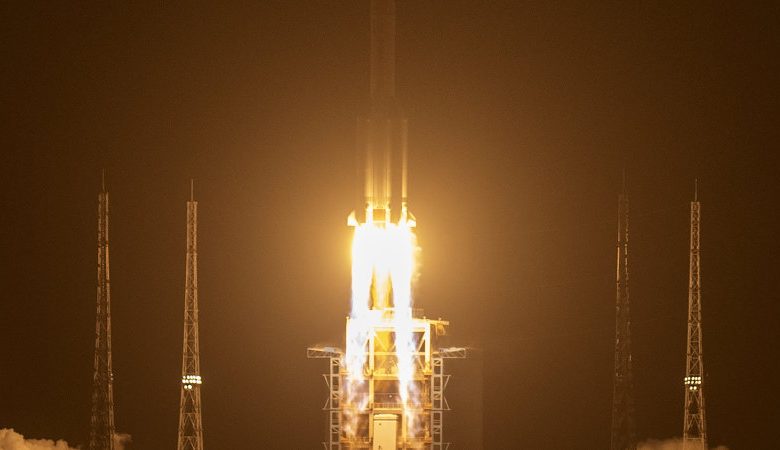China launches Chang’e 5 mission to bring back material from Moon

abc– China has launched an ambitious mission to bring back rocks and debris from the Moon’s surface for the first time in more than 40 years.
Key points:
- The rocket launched just after 4.30am on Tuesday
- The mission’s goal is to drill into the Moon and bring back 2 kilograms of rock
- The lander will spend the equivalent of about 14 Earth days on the Moon
Chang’e 5 — named for the Chinese moon goddess — is the country’s boldest lunar mission yet.
If successful, it would be a major advance for China’s space program, and some experts say it could pave the way for bringing samples back from Mars or even a crewed lunar mission.
The four modules of the Chang’e 5 spacecraft blasted off just after 4:30am on Tuesday (local time) atop a massive Long March-5Y rocket from the Wenchang launch centre on the southern island province of Hainan.
Minutes after launch, the spacecraft separated from the rocket’s first and second stages and slipped into an Earth-Moon transfer orbit.
About an hour later, Chang’e 5 opened its solar panels to provide its independent power source.
Spacecraft typically take three days to reach the Moon.
An opportunity not seen for more than 40 years
The launch was carried live by national broadcaster China Central TV, which then switched to computer animation to show its progress into outer space.
The mission’s key task is to drill 2 meters beneath the moon’s surface and scoop up about 2 kilograms of rocks and other debris to be brought back to Earth, according to NASA.
That would offer the first opportunity for scientists to study newly obtained lunar material since the American and Russian missions of the 1960s and 1970s.
The Chang’e 5 lander’s time on the Moon is scheduled to be short and sweet.
It can only stay one lunar daytime, or about 14 Earth days, because it lacks the radioisotope heating units to withstand the moon’s freezing nights.
The lander will dig for materials with its drill and robotic arm and transfer them to what’s called an ascender, which will lift off from the Moon and dock with the service capsule.
The materials will then be moved to the return capsule to be hauled back to Earth.
Mission ‘remarkable in many ways’
The technical complexity of Chang’e 5, with its four components, makes it “remarkable in many ways”, said Joan Johnson-Freese, a space expert at the US Naval War College.
“China is showing itself capable of developing and successfully carrying out sustained high-tech programs, important for regional influence and potentially global partnerships,” she said.
In particular, the ability to collect samples from space is growing in value, said Jonathan McDowell, an astronomer at the Harvard-Smithsonian Center for Astrophysics.
Other countries planning to retrieve material from asteroids or even Mars may look to China’s experience, he said.
While the mission is “indeed challenging,” McDowell said China has already landed twice on the Moon with its Chang’e 3 and Chang’e 4 missions, and showed with a 2014 Chang’e 5 test mission that it can navigate back to Earth, re-enter and land a capsule.
All that’s left is to show it can collect samples and take off again from the Moon.
“As a result of this, I’m pretty optimistic that China can pull this off,” he said.
The mission is among China’s boldest since it first put a man in space in 2003, becoming only the third nation to do so after the US and Russia.
China’s space agency moving into new territory
Chang’e 5 and future lunar missions aim to “provide better technical support for future scientific and exploration activities,” Pei Zhaoyu, mission spokesperson and deputy director of the Chinese National Space Administration’s Lunar Exploration and Space Engineering Center, told reporters at a Monday briefing.
“Scientific needs and technical and economic conditions” would determine whether China decides to send a crewed mission to the Moon, said Pei, whose comments were embargoed until after the launch.
“I think future exploration activities on the Moon are most likely to be carried out in a human-machine combination.”
While many of China’s crewed spaceflight achievements, including building an experimental space station and conducting a spacewalk, reproduce those of other countries from years past, the CNSA is now moving into new territory.
Chang’e 4 — which made the first soft landing on the Moon’s relatively unexplored far side almost two years ago — is currently collecting full measurements of radiation exposure from the lunar surface, information vital for any country that plans to send astronauts to the Moon.
China in July became one of three countries to have launched a mission to Mars, in China’s case an orbiter and a rover that will search for signs of water on the red planet.
The CNSA says the spacecraft Tianwen 1 is on course to arrive at Mars around February.

